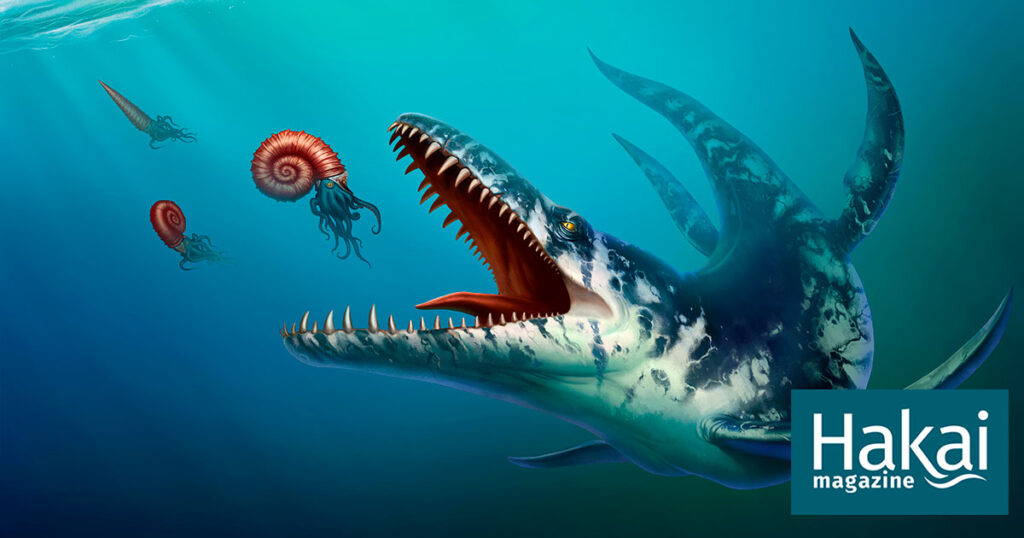

Ammonites—extinct marine cephalopods with distinctive coiled shells—are embedded in walls, floors, and roads all across town. Locals and visitors often find fossils when walking unpaved roads and hiking the trails around Villa de Leyva. Before former president Juan Manuel Santos signed a 2018 decree protecting the country’s paleontological heritage, street vendors sold fossils to passing tourists.
During the Lower Cretaceous, between 145 and 100 million years ago, this region of central Colombia was underwater, and these fossils were part of a complex and diverse marine ecosystem. Back then, this area was part of an ocean overlying a continental shelf next to the recently formed South America in the proto-Caribbean Sea. Its waters were relatively shallow, around 180–200 meters deep, and the bottom was toxic for most living things due to high levels of sulfuric acid and low levels of dissolved oxygen. When dead animals and plants fell to the ocean floor, the toxicity protected their remains from scavengers, helping to preserve them. When this portion of the Andes Mountains began to form—around 72 million years ago, according to a recent study—these fossils reached new heights, literally.
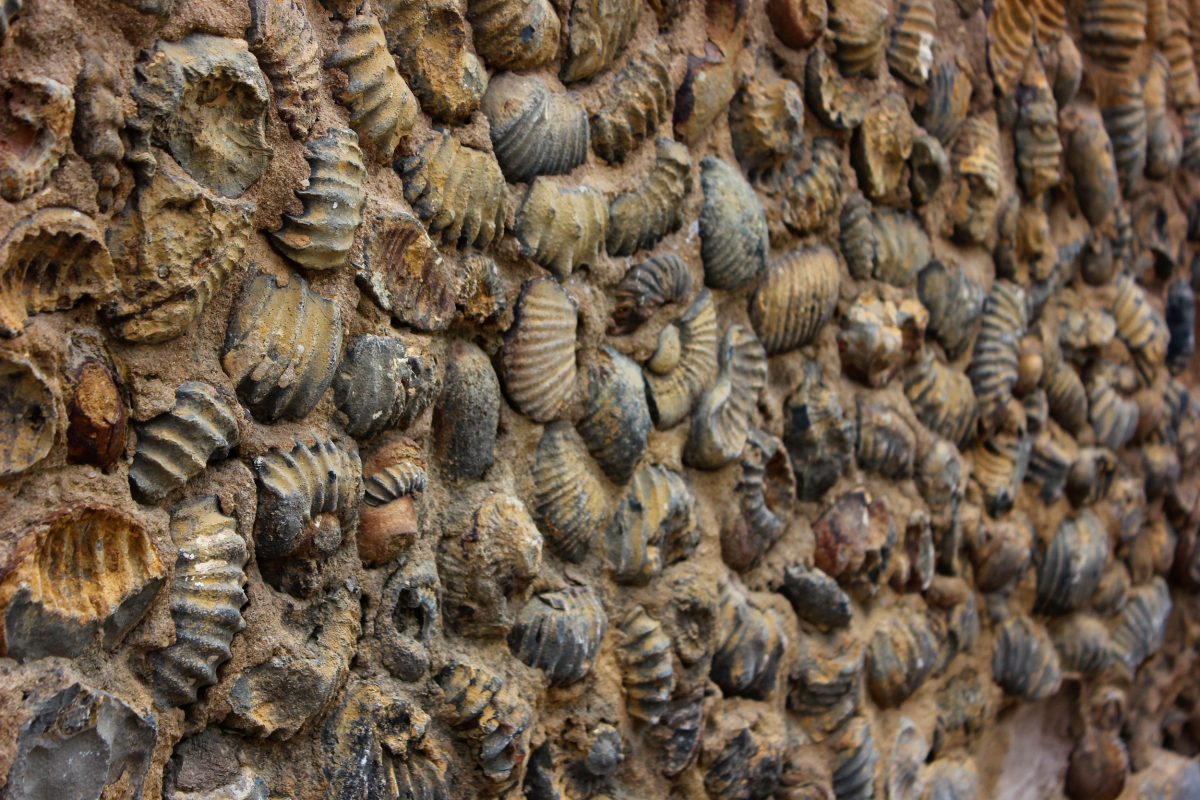
Ammonites are so common in some areas of Colombia that residents have embedded them in concrete walls and sidewalks. Photo by Andrea Pelaez/Shutterstock
The fossils around Villa de Leyva are part of what is known as the Paja Formation. This layer of sedimentary rock, partly formed from the former seafloor, has one of the world’s most complete records of the Lower Cretaceous marine fauna, and it is home to most of Colombia’s paleontological research.
A 10-meter-long short-necked pliosaur—found in 1977 by a farmer plowing his field—is the most famous fossil from the region. Amid a debate on proper nomenclature, the fossil is being referred to as Monquirasaurus (Kronosaurus) boyacensis. The impressive specimen became so well known in Colombia that a museum was built around it. In 2015, in the same region, Mary Luz Parra Ruge, the director of the Paleontological Research Center in Villa de Leyva, found Desmatochelys padillai, a 125-million-year-old marine turtle, one of the oldest in the world. And María Páramo, one of Colombia’s most important and prolific paleontologists, led the team that, in 2018, found and described Sachicasaurus vitae, another 10-meter-long pliosaur named after the town of Sáchica.
One hundred and thirty million years ago, countless ammonites of all shapes and sizes swam in the proto-Caribbean Sea alongside fishes and enormous marine predators. One of these was Kyhytysuka sachicarum, a five-meter-long aquatic reptile with an elongated swordlike skull and an arsenal of sharp teeth. This fearsome creature was not the largest animal of the tropical Cretaceous oceans: it was outclassed by several species of enormous long-necked plesiosaurs, such as the eight-meter-long Callawayasaurus colombiensis. At the top of the ecological food web were the two species of pliosaurs named above, each more than double the length of a full-grown great white shark.
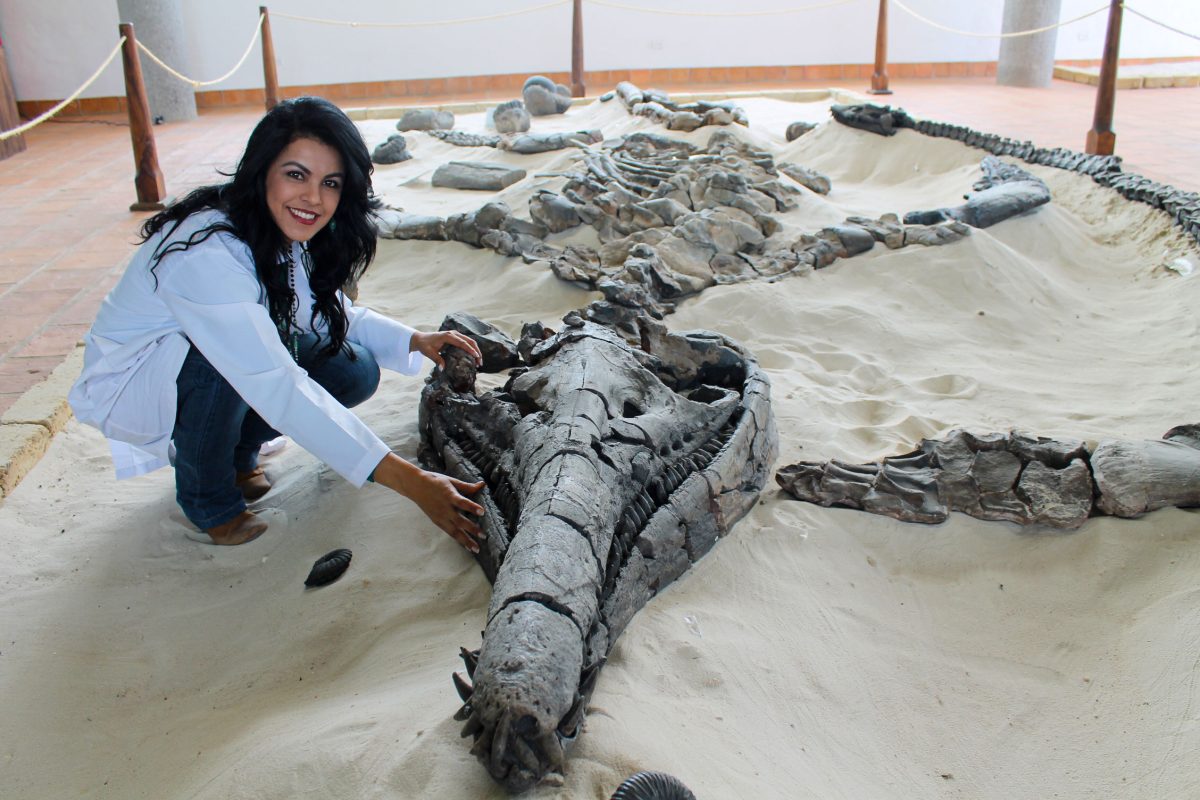
Paleontologist Mary Luz Parra Ruge poses with the skeleton of the predatory pliosaur Monquirasaurus (Kronosaurus) boyacensis. Photo courtesy of Paleontological Research Center at Villa de Leyva
“Swimming in those seas would have been terrifying,” says Dirley Cortés, a PhD candidate at McGill University in Ontario, who studies the evolution of the marine ecosystems in Colombia’s Cretaceous oceans. She adds that the biggest predators’ skulls are two meters long, big enough for these creatures to swallow most humans in one bite.
Cortés was born in Villa de Leyva and became interested in fossils as a child, often finding them on hikes with her family. As a high school student, she studied the jaw of a plesiosaur, and in university, she worked giving tours and prepping fossils at the Paleontological Research Center, a museum and research center dedicated to exploring and protecting the region’s fossils. She says many of the above-mentioned fossils can be found “practically in my backyard.”
Cortés always knew she wanted to become a paleontologist, but Colombian universities do not offer undergraduate paleontology degrees. So, despite being surrounded by fossils in her hometown, like many other Colombian paleontologists before her, she had to leave the country to study them at the postgraduate level. After receiving her bachelor’s degree in biology at a university in Tunja Cortés, she had the opportunity to work and study fossils in Panama and Germany before moving to Montreal to pursue a doctorate. Her focus at McGill University is the evolution of Cretaceous marine ecosystems in the tropics—specifically the fossils of the Paja Formation. Fossils from this region, she says, are both abundant and underinvestigated.
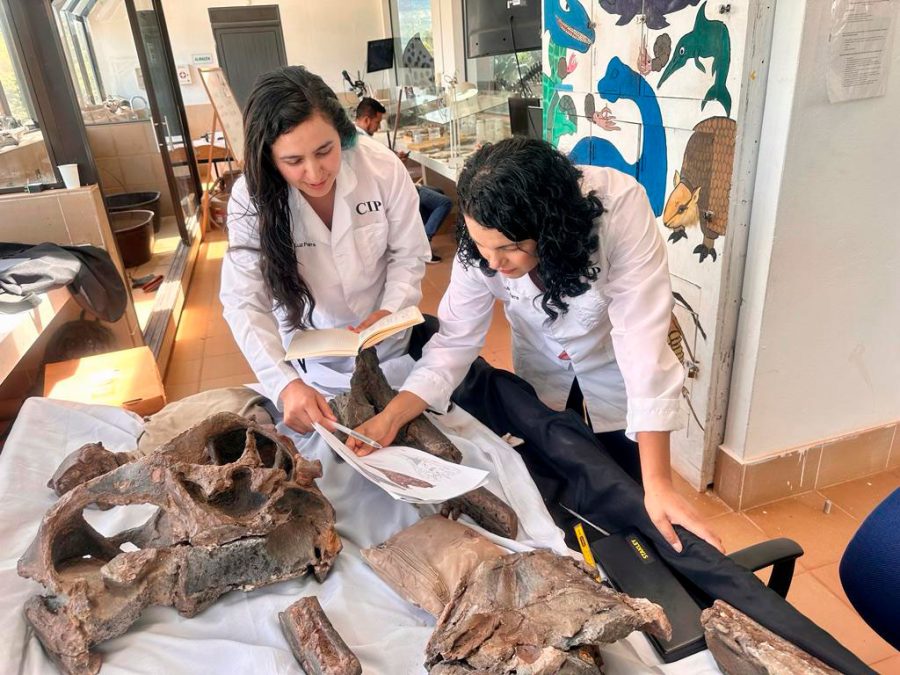
Dirley Córtes (left) and Mary Luz Parra Ruge examine fossils at the Paleontological Research Center. Photo courtesy of Paleontological Research Center at Villa de Leyva
Carlos Jaramillo, a prominent Colombian paleontologist with the Smithsonian Tropical Research Institute and Cortés’s mentor, agrees: “The fossils from the tropics have been relatively unexplored, even though they are abundant, and many are as well preserved as those from temperate regions.” The lack of knowledge about tropical fossils creates a bias in our shared understanding of deep time, ancient ecosystems, and the geological record. A study published in 2021 in Nature found that 97 percent of data collected, analyzed, and published in peer-reviewed journals about paleontology came from researchers in the global north. The authors argue that this inequality is a product of colonial history and global economics and distorts our understanding of paleontological biodiversity.
Today, Colombia is recognized globally as one of the most biodiverse countries, with more than 75,000 species identified. Colombia has the most species of orchids (more than 4,000), butterflies, and birds and is second in the world for plant diversity. Colombia is also abundant in paleontological specimens, with at least three rich fossiliferous locations: the Paja Formation near Villa de Leyva; the Cerrejón Formation in the north, known for the earliest fossil records of tropical rainforests on the continent, and where Titanoboa cerrejonensis, a gigantic snake longer than 10 meters, slithered 60 million years ago; and the Tatacoa Desert, home to fossil Cretaceous turtles, some of which were the size of a compact car.
And there might be even more fossil-rich regions still to be discovered. Héctor Daniel Palma-Castro, a master’s student in biology at Universidad Nacional de Colombia, also studies the fossils of the Paja Formation and says, “There are many places in the country on which I believe no paleontologist has put one foot.” For decades, confrontations between the government, left-wing guerrillas, right-wing paramilitary groups, and drug cartels limited the places scientists could visit and study. Following the 2016 peace accord between the government and FARC (Revolutionary Armed Forces of Colombia, the largest and oldest guerilla group on the continent), there was hope that researchers could explore new regions all across the country. However, in the last few months, a resurgence of violence by dissidents from FARC, other guerilla groups, and drug cartels has closed many regions to scientists once again.

Héctor Palma-Castro (right) works with a partner to uncover plant fossils in the Paja Formation. Photo courtesy of Héctor Palma-Castro
Palma-Castro, like Cortés, specializes in the fossils of the Paja Formation. However, when he digs, he looks for leaves, stems, branches, cones, and rare fossilized wood of trees that lived during the Lower Cretaceous. The ancient epicontinental sea bordered a forested coastline full of conifers, pines, and cypresses. Some remains of these flora—trees, leaves, and branches carried by a river to the ocean or plant fragments that may have been blown there by the wind—ended up sinking to the bottom of the ocean, where conditions were ideal for preservation. Finding fossils of ancient terrestrial plants next to marine creatures is not uncommon in the Paja Formation.
Palma-Castro studied the Paja Formation as an undergraduate in geology. With no paleontology departments or degrees in Colombia, the study of its ancient ecosystems has fallen to geologists. That was when he first became interested in the fossils of Lower Cretaceous plants; part of their attraction was that, despite their abundance, there had hardly been any research conducted on them. Once he completes his biology degree, he plans to apply to a PhD program in paleontology at a university outside Colombia. “The idea is to emigrate to keep studying, but always with the idea to keep working with fossil material from Colombia,” he adds.
The lack of academic and professional opportunities in paleontology is made worse by the need for more research funding. Government investment in science in Colombia has been dismal. Leaders across the political spectrum have failed to increase research funding, and the current government is presiding over its decline. Last October, legislators approved a nearly 18 percent reduction of the national science budget; in the debate, many House of Representatives members argued that when factoring in inflation, the real value of the reduction was closer to 25 percent.
Most Colombian paleontologists work for institutions in Europe or North America, where there are many more resources and career opportunities. They often continue to do fieldwork in Colombia, aiming to educate new students and the public. Some have been able to return as university professors and start small research groups and projects. “These small groups are tackling different branches of knowledge and between them slowly developing paleontology in Colombia,” says Cortés.
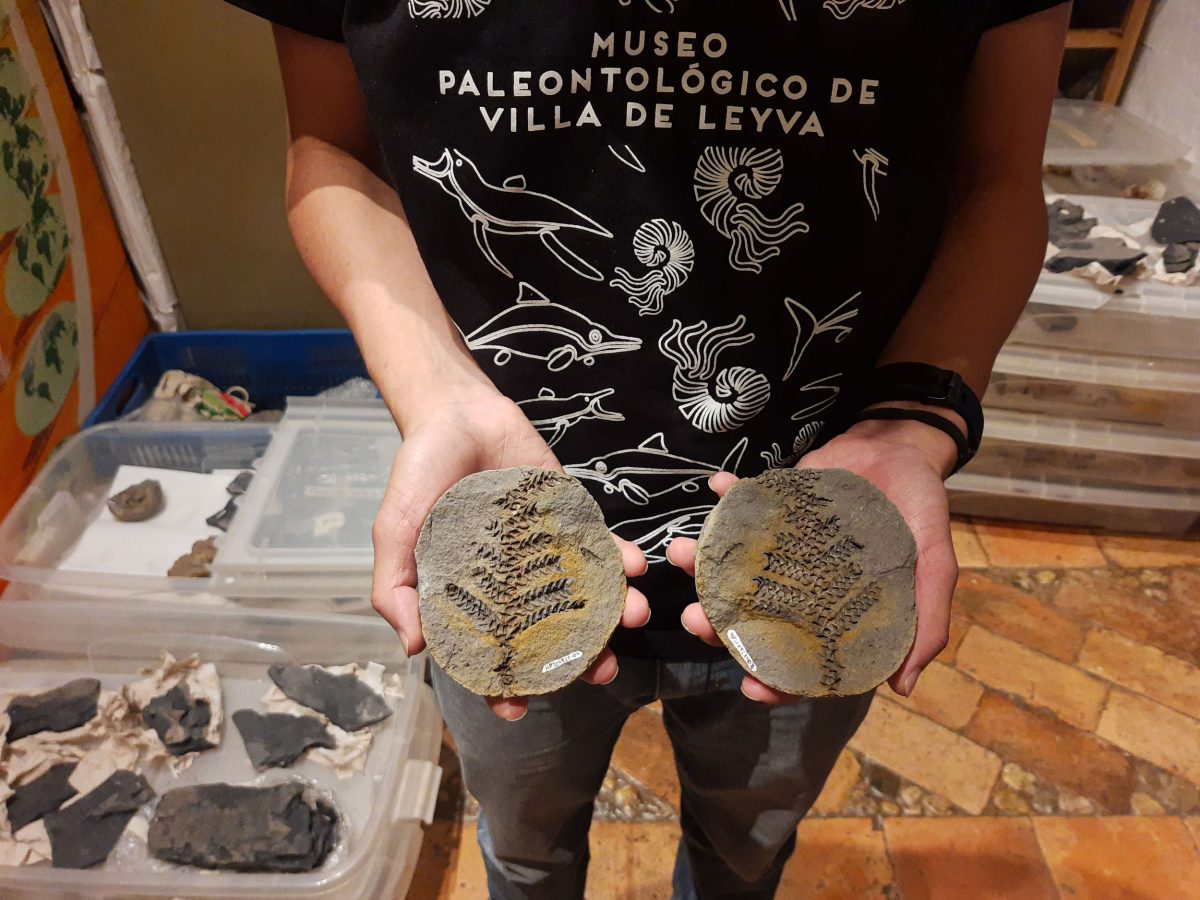
Palma-Castro shows fossil plant impressions found near Vélez in northeastern Colombia. Photo courtesy of Héctor Palma-Castro
As research about the country’s ancient past continues to increase, some of the obstacles in Colombia become more evident. The country lacks the technological tools required for more advanced research, such as microcomputed tomography, which uses X-rays to create virtual 3D models of the interior and exterior of an object without destroying it, or synchrotron radiation, which allows researchers to assess the chemical composition of fossils.
Many Colombian fossils found in the 20th century were taken out of the country—in some cases, by employees of the Tropical Oil Company that began petroleum extraction there in the 1920s—and ended up as far away as the University of California, Berkeley, and the American Museum of Natural History in New York.
Ironically, a 2018 decree intended to protect the country’s fossil heritage from this sort of dispossession has become another barrier to paleontologists. While essential to combating illegal poaching and trafficking of fossils, the law can be very restrictive. Palma-Castro spent a few months at the Field Museum in Chicago doing research for his thesis earlier this year. He wanted to use some of the equipment at the museum, but he could only take the fossils out of Colombia once he got the proper permits. Along with a slow bureaucracy at the Universidad Nacional de Colombia, this meant that by the time the fossil transfers were finally approved, Palma-Castro had left Chicago and was back in Colombia.
“I think that the outlook for Colombian paleontology is improving, but we need to do a lot more,” says Cortés. “There is lots of material to study, but we don’t even have a natural history museum.” Only a few small museums and universities in Colombia can properly store and display fossils, limiting citizens’ ability to learn from them.
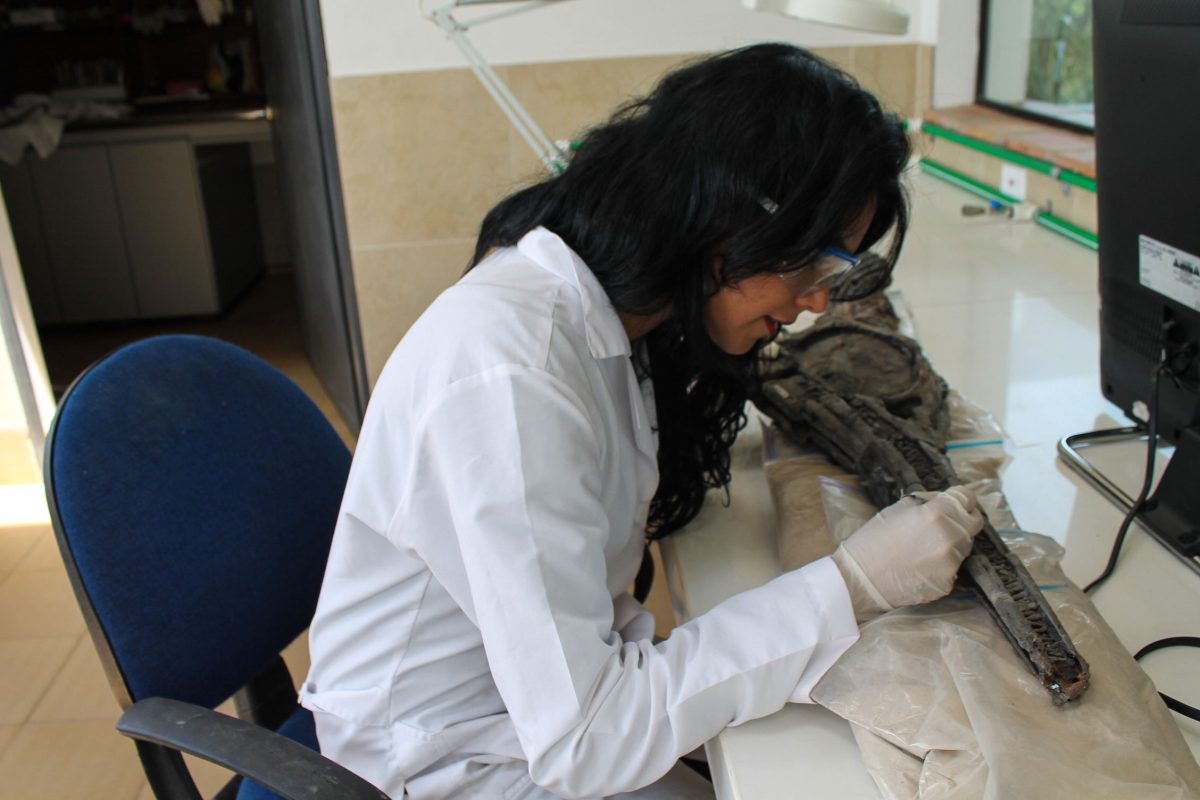
Mary Luz Parra Ruge examines the toothy skull of a fossil Kyhytysuka sachicarum. Photo courtesy of Paleontological Research Center at Villa de Leyva
“I dare to say that many children in Colombia dream about dinosaurs, might even be obsessed with them, but we don’t have many places adapted to encourage these interests,” adds Cortés.
The Paleontological Research Center in Villa de Leyva, one of the first places Cortés started to learn about fossils, is one of those few institutions. The center continues to encourage research from college and graduate students, promoting the value of its fossil exhibits to tourists and locals. One of its programs, Guardians of Paleontology, teaches K–12 students about ancient ecosystems and how to study them. Among the current students are a boy developing his own paleoencyclopedia and a girl with dreams of studying paleobotany.
Despite the many challenges and lack of funding, Colombian researchers keep looking for fossils, studying the paleontological record, and finding creative ways to share their work. Recently, 32 Colombian scientists contributed to the second edition of the book Hace Tiempo (Long Ago), writing chapters about their work and the fossils they study. This illustrated book aims to tell the history of Earth through the fossils found in the country. Cortés wrote the chapter about ancient marine reptiles; Jaramillo was one of the editors.
As the number of people who study ancient ecosystems continues to grow, there is optimism for the future of paleontology in Colombia. New locations will be explored, and many more unknown species are waiting to be found. “Imagination falls short of what we might find in the future,” says Palma-Castro.